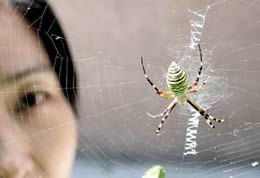
Spiders and Spider Bites: A Comprehensive Guide
Spiders are fascinating creatures that have intrigued humans for centuries. With over 48,000 species documented worldwide, these arachnids come in a variety of shapes, sizes, and colors. While many spiders are harmless, a few can deliver venomous bites that can cause discomfort or even be life-threatening. In this article, we will delve into the world of spiders and spider bites, exploring their characteristics, the risks associated with their bites, and the necessary steps to take if you are bitten by a spider.
Understanding Spiders

Spiders belong to the class Arachnida, which also includes scorpions, ticks, and mites. They have eight legs, two pairs of antennae, and a segmented body. Unlike insects, spiders have no wings or antennae, and their bodies are divided into two main parts: the cephalothorax (head and thorax) and the abdomen. Spiders are known for their silk-producing glands, which they use to create webs, lines, and other structures.
Spiders can be found in almost every habitat on Earth, from rainforests to deserts, and from mountains to the deep sea. They play a crucial role in their ecosystems by controlling insect populations and serving as a food source for other animals. However, some spiders are known for their venomous bites, which can cause a range of symptoms from mild to severe.
Common Venomous Spiders

While many spider bites are harmless, a few species are venomous and can cause serious health issues. Here are some of the most common venomous spiders:
| Spider Species | Location | Notable Features |
|---|---|---|
| Black Widow | North America, South America | Red hourglass mark on abdomen |
| Brown Recluse | North America | Light to dark brown color, violin-shaped mark on back |
| Funnel-Web Spider | Australia, New Guinea | Long, slender body, dark coloration |
| Yellow Sac Spider | North America | Yellow or cream color, sac-like web |
Risks Associated with Spider Bites

Spider bites can range from mild to severe, depending on the species and the individual’s immune response. Here are some of the risks associated with spider bites:
-
Mild symptoms: Pain, redness, swelling, and itching at the bite site.
-
Severe symptoms: Nausea, vomiting, fever, chills, muscle pain, and in some cases, organ failure or death.
It is important to note that not everyone will experience symptoms after a spider bite, and some individuals may be allergic to spider venom, which can lead to anaphylaxis, a life-threatening allergic reaction.
What to Do If You Are Bitten by a Spider
If you are bitten by a spider, here are some steps to take:
-
Keep calm and try to remain still to prevent the venom from spreading.
-
Wash the bite area with soap and water to clean the wound.
-
Apply a cold compress to reduce swelling and pain.
-
Seek medical attention if you experience severe symptoms, such as difficulty breathing, swelling of the throat, or signs of anaphylaxis.
In some cases, your doctor may prescribe medication to treat the symptoms or provide antivenom if you have been bitten by a venomous spider.
Preventing Spider Bites
While it is impossible to completely avoid spider bites, there are steps you can take to reduce your risk:
-
Keep your home clean and clutter-free to discourage spiders from taking up residence.
-
Seal gaps and cracks around your home to prevent spiders from entering.
Related Posts
minor dog bite bruise,Understanding the Minor Dog Bite Bruise: A Comprehensive Guide
Understanding the Minor Dog Bi…
twitch best 10 bit cheer,Twitch Best 10 Bit Cheer: A Comprehensive Guide
Twitch Best 10 Bit Cheer: A Co…





